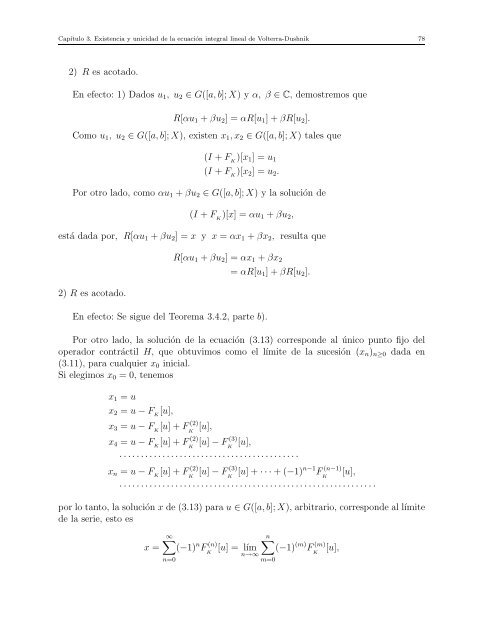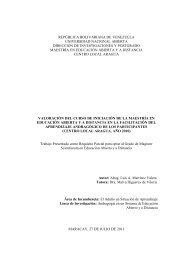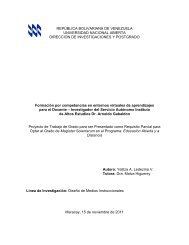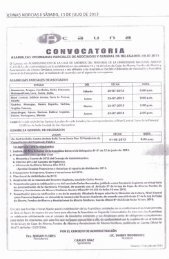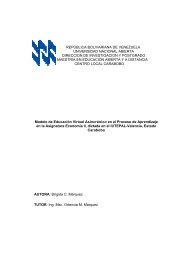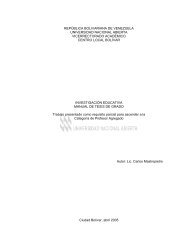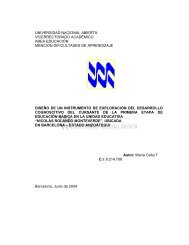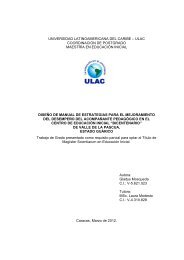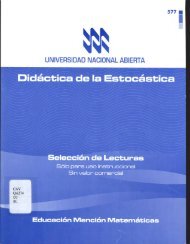Ecuaciones Integrales Lineales de Volterra-Dushnik en Espacios de ...
Ecuaciones Integrales Lineales de Volterra-Dushnik en Espacios de ...
Ecuaciones Integrales Lineales de Volterra-Dushnik en Espacios de ...
You also want an ePaper? Increase the reach of your titles
YUMPU automatically turns print PDFs into web optimized ePapers that Google loves.
Capítulo 3. Exist<strong>en</strong>cia y unicidad <strong>de</strong> la ecuación integral lineal <strong>de</strong> <strong>Volterra</strong>-<strong>Dushnik</strong> 782) R es acotado.En efecto: 1) Dados u 1 , u 2 ∈ G([a, b]; X) y α, β ∈ C, <strong>de</strong>mostremos queR[αu 1 + βu 2 ] = αR[u 1 ] + βR[u 2 ].Como u 1 , u 2 ∈ G([a, b]; X), exist<strong>en</strong> x 1 , x 2 ∈ G([a, b]; X) tales que(I + F K)[x 1 ] = u 1(I + F K)[x 2 ] = u 2 .Por otro lado, como αu 1 + βu 2 ∈ G([a, b]; X) y la solución <strong>de</strong>(I + F K)[x] = αu 1 + βu 2 ,está dada por, R[αu 1 + βu 2 ] = x y x = αx 1 + βx 2 , resulta que2) R es acotado.R[αu 1 + βu 2 ] = αx 1 + βx 2= αR[u 1 ] + βR[u 2 ].En efecto: Se sigue <strong>de</strong>l Teorema 3.4.2, parte b).Por otro lado, la solución <strong>de</strong> la ecuación (3.13) correspon<strong>de</strong> al único punto fijo <strong>de</strong>loperador contráctil H, que obtuvimos como el límite <strong>de</strong> la sucesión (x n ) n≥0 dada <strong>en</strong>(3.11), para cualquier x 0 inicial.Si elegimos x 0 = 0, t<strong>en</strong>emosx 1 = ux 2 = u − F K[u],x 3 = u − F K[u] + F (2) [u], Kx 4 = u − F K[u] + F (2) (3)[u] − F [u],K K· · · · · · · · · · · · · · · · · · · · · · · · · · · · · · · · · · · · · · · · · ·x n = u − F K[u] + F (2) (3)[u] − F [u] + · · · + (−1)n−1 F (n−1) [u],K KK· · · · · · · · · · · · · · · · · · · · · · · · · · · · · · · · · · · · · · · · · · · · · · · · · · · · · · · · · · · ·por lo tanto, la solución x <strong>de</strong> (3.13) para u ∈ G([a, b]; X), arbitrario, correspon<strong>de</strong> al límite<strong>de</strong> la serie, esto esx =∞∑n=0(−1) n F (n)K[u] = límn∑n→∞m=0(−1) (m) F (m)K[u],


